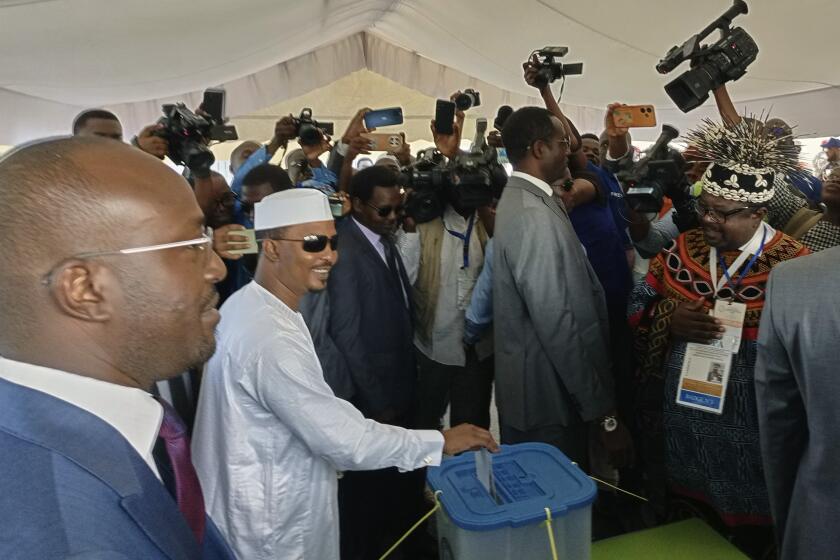New Worries Raised About Space Station : Controversy: McDonnell Douglas in Orange County is said to have hit a developmental snag, and a new GAO report questions NASA’s reserve funding.
A week before the House decides the fate of the planned Space Station Freedom, congressional investigators and others are raising new questions about near-term technical problems at McDonnell Douglas in Orange County and the long-term cost of the controversial project.
A new report by the General Accounting Office, the investigative arm of Congress, questions whether the National Aeronautics and Space Administration has set aside enough money to pay for unbudgeted work or unexpected problems in the development of the $30-billion orbiting space laboratory.
GAO investigators believe that contractor cost overruns or other unanticipated difficulties could put the program substantially over budget, seriously disrupt its schedule and send NASA scurrying back to Congress to seek more money later in the decade.
“We were very concerned about the level of reserves (last year), and we remain very concerned today, even more so,” said a senior GAO official, who asked not to be named. The GAO report has not yet been made public.
Industry sources say problems are already cropping up. The largest space station contractor, McDonnell Douglas Space Systems Co. of Huntington Beach, has hit snags in its development of cooling systems and data management software for the station’s computers, according to a report in Thursday’s edition of Space Station News, a Washington-based newsletter.
The newsletter quoted unnamed NASA officials as saying that the additional costs associated with solving those problems could total $500 million to $1 billion, an assertion denied Thursday by McDonnell Douglas spokesman Thomas E. Williams.
Williams declined to release specific figures but said that any extra costs associated with McDonnell Douglas’ $3.5-billion space station contract are generally due to changes in the space station construction schedule made by NASA. McDonnell Douglas and NASA are about to begin talks on how much of those costs NASA will pay.
The cost problems at McDonnell Douglas have forced NASA to slow the work of other contractors. Earlier this year, for example, NASA ordered Sunnyvale-based Lockheed Missiles and Space Co. to delay some work on the station’s solar panels to accommodate more spending this year at McDonnell Douglas, sources said.
A senior NASA official, who asked not to be named, said Thursday that the reserve funding for the space station is adequate, that design problems are not unusual for such a complex research and development project and that the problems will be solved.
“Our program manager has looked at it; our program associate administrator has looked at it. I think all reserves are tight, but they believe it’s manageable,” the official said.
Williams of McDonnell Douglas agreed. “Every year, as we get close to the resolution of the budget issue, there seem to be folks looking to scratch the paint on the station. I think someone is attempting to make this into a major issue, and it’s not,” he said.
Space station work accounts for about a third of McDonnell Douglas Space Systems’ business and occupies about 1,500 of the company’s Orange County workers.
Neither NASA nor GAO officials would provide precise figures on NASA’s reserve funding. However, a GAO source said the agency has calculated reserves at about 15% of the estimated program cost, instead of an optimum reserve level of 30% to 35%.
NASA has squeezed its reserves, the source said, by planning to use them to pay for work Congress has refused to fund in regular appropriations, such as a $2-billion “escape” capsule to transport astronauts back to Earth in case of an emergency.
The new questions about the cost of the space station come at a critical time for the program, which faces serious opposition from those in Congress who argue that in a tough economic environment, the nation should not spend billions of dollars on space ventures.
“Space Station Freedom will become a budgetary black hole in space, sucking in money that would otherwise be allocated to many other important agencies,” Rep. Richard J. Durbin (D-Ill.) said Thursday at a Capitol Hill press conference.
Durbin said that a bipartisan coalition of House members, including Rep. Bob Traxler (D-Mich.), who chairs the appropriations subcommittee that funds NASA, will move to cut virtually all funding for the space station when the House debates NASA’s appropriation for the 1993 fiscal year. The debate is scheduled for Wednesday, and both sides say the vote will be close.
After a lengthy debate last year, the House voted 240 to 173 to continue the program. The Senate followed suit with a 64-35 vote.
The fate of the space station is of particular interest in Southern California, where two of the program’s three prime contractors--McDonnell Douglas and the Canoga Park-based Rocketdyne Division of Rockwell International--hold contracts worth more than $5 billion.
In an expected move, the House Appropriations Committee voted Thursday to spend $1.725 billion on the space station in the 1993 fiscal year, which begins Oct. 1. That amount is $525 million less than requested by the Bush Administration and nearly $300 million less than Congress appropriated for 1992. That level of funding could push back the planned launch of the first space station components in November, 1995, according to industry sources.
The committee approved a total NASA budget of $14.03 billion, $963 million less than NASA had requested.
The space station’s supporters in Congress and NASA’s new administrator, Daniel S. Goldin, in recent weeks have mounted a spirited defense of the program, which has been in the planning stages since 1984.
Goldin and congressional supporters argue that the United States needs the space station to fulfill its destiny as a space-faring nation. A permanently orbiting laboratory would allow scientists to study the long-term effects of weightlessness on humans in preparation for 21st-Century manned missions back to the moon and to Mars, they say.
They also suggest that the biomedical and micro-gravity research to be conducted aboard the station could have significant benefits on Earth, including possible breakthroughs in the study of diseases such as cancer and AIDS.
More to Read
Start your day right
Sign up for Essential California for news, features and recommendations from the L.A. Times and beyond in your inbox six days a week.
You may occasionally receive promotional content from the Los Angeles Times.






